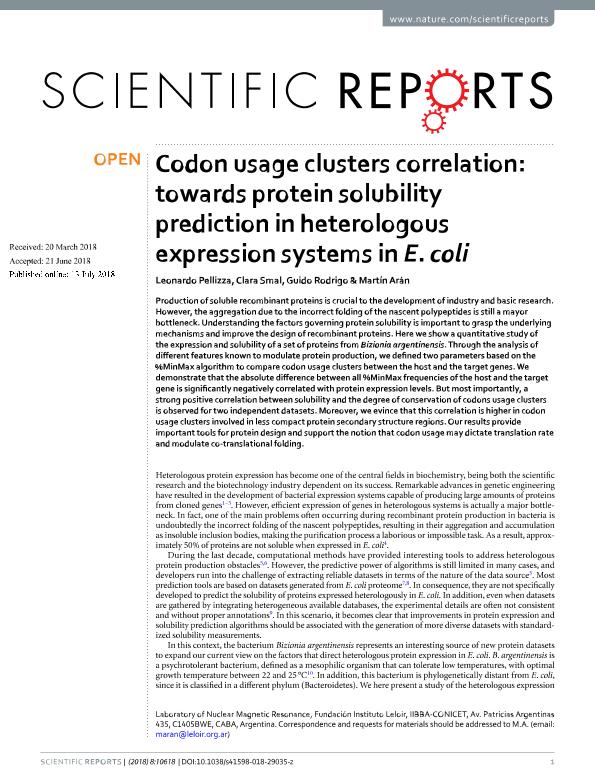Mostrar el registro sencillo del ítem
dc.contributor.author
Pellizza Pena, Leonardo Agustín

dc.contributor.author
Smal, Clara

dc.contributor.author
Rodrigo, Guido
dc.contributor.author
Aran, Martin

dc.date.available
2019-12-04T15:29:35Z
dc.date.issued
2018-12
dc.identifier.citation
Pellizza Pena, Leonardo Agustín; Smal, Clara; Rodrigo, Guido; Aran, Martin; Codon usage clusters correlation: Towards protein solubility prediction in heterologous expression systems in E. coli; Nature Publishing Group; Scientific Reports; 8; 1; 12-2018; 1-12
dc.identifier.issn
2045-2322
dc.identifier.uri
http://hdl.handle.net/11336/91344
dc.description.abstract
Production of soluble recombinant proteins is crucial to the development of industry and basic research. However, the aggregation due to the incorrect folding of the nascent polypeptides is still a mayor bottleneck. Understanding the factors governing protein solubility is important to grasp the underlying mechanisms and improve the design of recombinant proteins. Here we show a quantitative study of the expression and solubility of a set of proteins from Bizionia argentinensis. Through the analysis of different features known to modulate protein production, we defined two parameters based on the %MinMax algorithm to compare codon usage clusters between the host and the target genes. We demonstrate that the absolute difference between all %MinMax frequencies of the host and the target gene is significantly negatively correlated with protein expression levels. But most importantly, a strong positive correlation between solubility and the degree of conservation of codons usage clusters is observed for two independent datasets. Moreover, we evince that this correlation is higher in codon usage clusters involved in less compact protein secondary structure regions. Our results provide important tools for protein design and support the notion that codon usage may dictate translation rate and modulate co-Translational folding.
dc.format
application/pdf
dc.language.iso
eng
dc.publisher
Nature Publishing Group

dc.rights
info:eu-repo/semantics/openAccess
dc.rights.uri
https://creativecommons.org/licenses/by-nc-sa/2.5/ar/
dc.subject
Production of soluble recombinant proteins
dc.subject
%MinMax algorithm
dc.subject
Bizionia argentinensis
dc.subject.classification
Otros Tópicos Biológicos

dc.subject.classification
Ciencias Biológicas

dc.subject.classification
CIENCIAS NATURALES Y EXACTAS

dc.title
Codon usage clusters correlation: Towards protein solubility prediction in heterologous expression systems in E. coli
dc.type
info:eu-repo/semantics/article
dc.type
info:ar-repo/semantics/artículo
dc.type
info:eu-repo/semantics/publishedVersion
dc.date.updated
2019-10-22T17:38:05Z
dc.journal.volume
8
dc.journal.number
1
dc.journal.pagination
1-12
dc.journal.pais
Reino Unido

dc.description.fil
Fil: Pellizza Pena, Leonardo Agustín. Consejo Nacional de Investigaciones Científicas y Técnicas. Oficina de Coordinación Administrativa Parque Centenario. Instituto de Investigaciones Bioquímicas de Buenos Aires. Fundación Instituto Leloir. Instituto de Investigaciones Bioquímicas de Buenos Aires; Argentina
dc.description.fil
Fil: Smal, Clara. Consejo Nacional de Investigaciones Científicas y Técnicas. Oficina de Coordinación Administrativa Parque Centenario. Instituto de Investigaciones Bioquímicas de Buenos Aires. Fundación Instituto Leloir. Instituto de Investigaciones Bioquímicas de Buenos Aires; Argentina
dc.description.fil
Fil: Rodrigo, Guido. Consejo Nacional de Investigaciones Científicas y Técnicas. Oficina de Coordinación Administrativa Parque Centenario. Instituto de Investigaciones Bioquímicas de Buenos Aires. Fundación Instituto Leloir. Instituto de Investigaciones Bioquímicas de Buenos Aires; Argentina
dc.description.fil
Fil: Aran, Martin. Consejo Nacional de Investigaciones Científicas y Técnicas. Oficina de Coordinación Administrativa Parque Centenario. Instituto de Investigaciones Bioquímicas de Buenos Aires. Fundación Instituto Leloir. Instituto de Investigaciones Bioquímicas de Buenos Aires; Argentina
dc.journal.title
Scientific Reports
dc.relation.alternativeid
info:eu-repo/semantics/altIdentifier/url/http://www.nature.com/articles/s41598-018-29035-z
dc.relation.alternativeid
info:eu-repo/semantics/altIdentifier/doi/http://dx.doi.org/10.1038/s41598-018-29035-z
Archivos asociados
